Myth Busted!
Lee Trevino once quipped: If you are caught on a golf course during a storm and are afraid of lightning, hold up a 1-iron. Not even God can hit a 1-iron.
Though it has been long believed that golfers would hold this top spot, according to a recent detailed analysis by NOAA of lightning deaths in the United States, golfers do NOT account for the most sports related lightning fatalities. Out of the 12 activities which accounted for the most, golf was tied for number 8. The sad No.1 spot belongs to fishing, which accounts for twice as many as number 2, camping.
Some interesting charts and graphs are included below. As one can see, Mother Nature apparently doesn’t like men, since 81% of the time they are the target.
In fact, a quick overview of the data suggests that if you’re a guy, aged 20-29, and it’s a Saturday in July, and your buddies invite you to go fishing on a boat, and there are possible storms in the forecast, either decline the invitation, or bring your 1 iron.
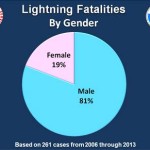
By Gender

By Age
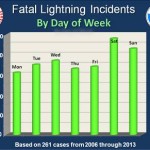
Day of Week
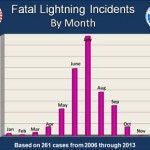
By Month
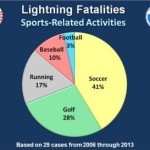
Sports Activities
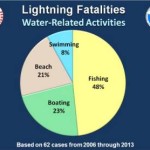
Water Activities
Fortunately, lightning deaths are preventable. The key is to react to signs of approaching storms. If you don’t have time to read this complete report, then some of the key lightning safety take-a-ways are these:
- Lightning often strikes outside the area of heavy rain and may strike as far as 10 miles from any rainfall. Many lightning deaths occur ahead of storms or after storms have seemingly passed.
- If you can hear thunder, you are in danger. Don’t be fooled by blue skies. If you hear thunder, lightning is close enough to pose an immediate threat.
- Have a lightning safety plan. Know where you’ll go for safety and how much time it will take to get there. Make sure your plan allows enough time to reach safety.
- Postpone activities. Before going outdoors, check the forecast for thunderstorms. Consider postponing activities to avoid being caught in a dangerous situation.
- Monitor the weather. Look for signs of a developing thunderstorm such as darkening skies, flashes of lightning or increasing wind.
- Get to a safe place. If you hear thunder, even a distant rumble, immediately move to a safe place. Fully enclosed buildings with wiring and plumbing provide the best protection. Sheds, picnic shelters, tents or covered porches do NOT protect you from lightning. If a sturdy building is not nearby, get into a hard-topped metal vehicle and close all the windows. Stay inside until 30 minutes after the last rumble of thunder.
- If you hear thunder, don’t use a corded phone except in an emergency. Cordless phones and cell phones are safe to use.
- Keep away from electrical equipment and wiring. Water pipes conduct electricity.
- Don’t take a bath or shower or use other plumbing during a storm.
Here in Florida, we have more than our share of lightning – well over 1 Million hits per year, ranking us No.1 in the United States. So, no matter the sport or activity that you’re enjoying, don’t get in harm’s way. Remember to Play it Safe and Get Indoors When Thunder Roars!

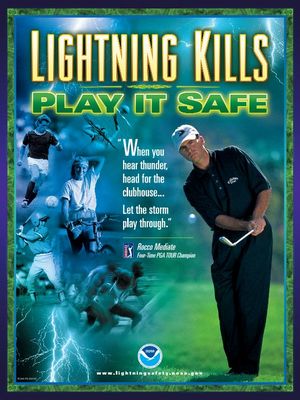
















Leave a Reply